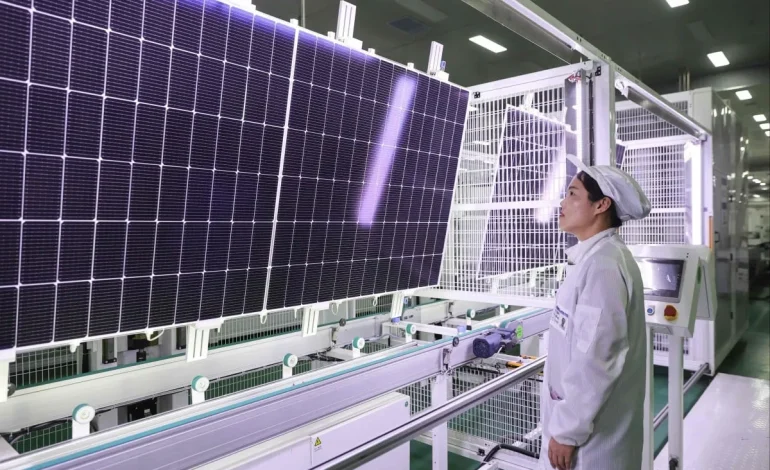China Green Tech Exports Hit Record Levels

Introduction
China’s green technology exports reached record levels in Q3 2025, reflecting the country’s expanding role in global clean energy and sustainable industrial solutions. According to data from the Ministry of Commerce (MOFCOM), green tech exports, including solar panels, wind turbines, energy storage systems, and electric vehicle components, totaled $14.8 billion in Q3, a 30% increase from the same period in 2024. Analysts attribute this growth to rising international demand for renewable energy infrastructure and China’s strong domestic manufacturing capabilities.
Drivers of Export Growth
The surge in green technology exports is fueled by multiple factors, including government support, technological innovation, and increasing global commitments to carbon reduction. The Ministry of Science and Technology (MOST) has provided subsidies and tax incentives for green technology manufacturers, enabling them to scale production and reduce costs for international buyers.
Wang Lei, Senior Analyst at the China Renewable Energy Association, stated, “China’s dominance in green tech manufacturing is a combination of policy support, advanced production techniques, and efficient supply chains. The recent export growth demonstrates the competitiveness of Chinese products in international markets.”
Internationally, the push toward net-zero emissions has driven demand for solar panels, wind turbines, and energy-efficient industrial machinery. European Union countries, Southeast Asia, and parts of Africa accounted for nearly 60% of China’s green tech exports, signaling robust global interest.
Sector Breakdown of Green Tech Exports
- Solar Panels and Photovoltaic Systems: $5.2 billion, 35% of total exports, driven by demand in Europe and Southeast Asia
- Wind Turbines and Components: $3.8 billion, 25.7% of exports, with offshore wind projects in the EU and Asia
- Energy Storage Solutions: $2.5 billion, 16.9%, including lithium-ion batteries for EVs and grid storage
- Electric Vehicle Components: $2.1 billion, 14.2%, encompassing powertrains, motors, and battery modules
- Other Green Technologies: $1.2 billion, 8.2%, including smart meters and industrial energy management systems
The combination of renewable energy products and electrification solutions is enabling China to strengthen its position as a global supplier of sustainable technology, supporting climate goals worldwide.
Technological Innovation and Competitiveness
China’s green technology sector is increasingly innovation-driven. Solar manufacturers such as LONGi Green Energy and JA Solar have improved efficiency levels of photovoltaic cells beyond 24%, reducing installation costs for international buyers. Wind turbine producers like Goldwind and MingYang Smart Energy are deploying larger, high-capacity offshore turbines capable of generating 15 MW per unit, increasing competitiveness in the global market.
Energy storage innovations are also notable. Companies like CATL and BYD have introduced modular lithium-ion and solid-state batteries, facilitating flexible deployment in grid-scale and EV applications. These technologies allow international clients to integrate energy storage systems efficiently, reducing operational costs and improving renewable energy utilization.
Policy Support and International Collaboration
Chinese government policies play a critical role in enabling export growth. MOFCOM and the Ministry of Ecology and Environment (MEE) offer export rebates, financing support, and logistical assistance for green tech manufacturers. Exporters also benefit from trade facilitation agreements with partner countries in Southeast Asia, Africa, and Europe.
International collaboration has increased through joint ventures, technology transfer programs, and research partnerships. For example, Chinese companies are working with European solar research institutes to enhance efficiency and develop recycling solutions for end-of-life panels. Wang Lei noted, “Collaborative R&D is crucial for maintaining technological leadership and responding to evolving global environmental standards.”
Market Impact and Economic Significance
The growth of green tech exports contributes to China’s industrial upgrade strategy while generating foreign exchange earnings. Analysts estimate that Q3 exports supported over 120,000 domestic jobs, from factory production lines to research and logistics operations. The revenue also incentivizes further investment in domestic R&D, creating a virtuous cycle of innovation and export competitiveness.
Export trends indicate that demand for renewable energy solutions will remain robust in the medium term. International energy transition policies, such as the European Green Deal and Southeast Asia’s renewable energy targets, are expected to sustain strong import needs for Chinese solar panels, wind turbines, and battery solutions.
Challenges and Considerations
Despite impressive growth, Chinese green tech exporters face several challenges. Supply chain constraints, including raw material availability for lithium, cobalt, and rare earth elements, could limit production capacity. Rising global competition from South Korea, Germany, and the United States in high-efficiency solar panels and wind turbines also poses pressure.
Regulatory compliance is another critical factor. International standards for emissions, product safety, and recycling require ongoing adaptation by Chinese manufacturers. Experts note that maintaining technological leadership and quality assurance is essential to retain global market share.
Future Outlook
Looking ahead, analysts project continued export growth in Q4 2025 and 2026. MOFCOM forecasts total annual green tech exports could exceed $60 billion by year-end, driven by rising adoption of renewable energy infrastructure worldwide. Key areas for growth include offshore wind, energy storage systems, and next-generation electric vehicle components.
Technological advancements, including AI-enabled energy management, smart grids, and modular energy storage, are expected to enhance the value of Chinese exports. Some companies are exploring digital settlement systems for trade transactions, providing faster and more secure cross-border payments, which could improve liquidity and operational efficiency for global clients.
Conclusion
China’s record-breaking green technology exports in Q3 2025 demonstrate the country’s growing leadership in renewable energy and sustainable industrial solutions. Policy support, technological innovation, and international collaboration have enabled manufacturers to deliver high-quality, cost-competitive products to global markets. While challenges such as supply chain constraints, international competition, and regulatory compliance remain, the sector’s performance underscores China’s capacity to drive both domestic industrial upgrading and global clean energy adoption. Continued investment in R&D, scalable production, and cross-border collaboration will further strengthen China’s role as a key supplier of green technologies in the years ahead.






